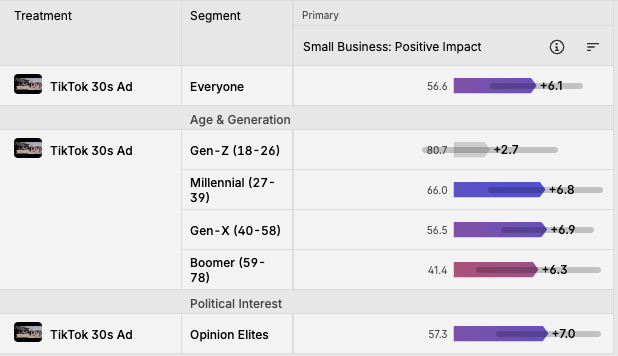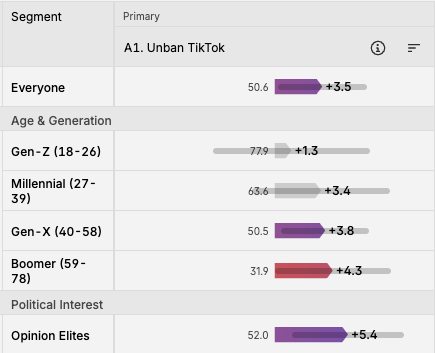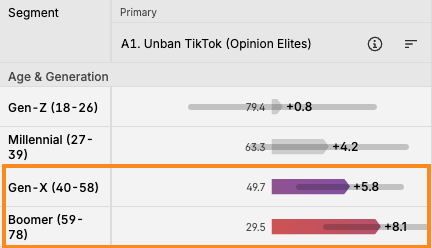Divided We Scroll (Part 3): TikTok Makes Waves Among Opinion Elites
This is the third installment of our series on TikTok's future and its response to a recent House Bill that could ban TikTok in the US. In this post, we look at TikTok's first linear TV ad. TikTok announced a $2.1 million ad buy over the weekend, running in key swing states of Ohio, Pennsylvania, Montana, Wisconsin, and Nevada.
Swayable ran a Randomized Controlled Trial (RCT) to test TikTok's new TV ad to see if it was persuasive among key audiences: Opinion Elites, older Americans, and non-TikTok Users.
Takeaways
- Benefits for small businesses: TikTok's ad was highly effective at increasing the belief that TikTok has a positive effect on small businesses.
- Effective among key audiences: The ad had minimal effect on younger Americans and people who use TikTok regularly, but it was successful at moving Older Americans and Opinion Elites to oppose a TikTok Ban.
- Some risks: However, some Older Americans argued that there are other apps that provide the same benefits; which TikTok may need to respond to.
Our first installment examined public attitudes toward the TikTok ban bill. We found that older Americans overwhelmingly support the legislation. In addition, Republicans support it slightly more than Democrats do. And lastly, large percentages of non-White ethnic groups are still undecided on the issue.
Our second installment looked at various organic TikToks to see what messages were persuasive for and against a TikTok ban. We found that CEO Shou Zi Chew's direct-to-camera appeal was highly persuasive among key audiences.
We believe Opinion Elites are a critical segment for TikTok to win over. We defined Opinion Elites as people who have high income, high education, and relevant job titles or high news/political interest.
TikTok's positive effect on small businesses
TikTok's ad argues that it's an essential platform for small businesses. However, do audiences resonate with this argument?
Our RCT test showed that this argument was highly persuasive. It increased the belief that TikTok positively impacts small businesses by 6 points overall, including a 7-point impact among Millennials and Gen-X.
This effect was also strong among key audiences: Baby Boomers and Opinion Elites. In the control group, Baby Boomers had the lowest baseline perception of TikTok: only 40% agreed that TikTok has a positive effect on small businesses. The ad increased this by 6 points.
Among Opinion Elites, the ad increased the perception by 7 points.

Moving older Americans and "Opinion Elites" to oppose a TikTok Ban
TikTok's most important outcome metric is moving people to oppose the potential ban. Among the "Everyone" segment, the effect was only 3.5 points. However, when we look at the age breakdowns, we can see that the underperformance is because the content had no effect on younger audiences, who largely already support TikTok.
Instead, the ad had its greatest impact on older populations: +4 points among Gen-X and Baby Boomers. In addition, it moved Opinion Elites, by 5 points to oppose a TikTok ban.

To examine this effect further, we studied the breakdown by age within Opinion Elites. We found this age effect even more pronounced: The ad moved Gen-X Opinion Elites by 6 points and Baby Boomer Opinion Elites by 8 points. These segments are critical for TikTok to win, and this ad achieves what they need.

Risk of rebuttal from older Americans who look to alternative apps to provide these benefits
At Swayable, we love asking "why" after uncovering the quantitative impact. For that, we look at the open-ended responses that our platform gathers. Among older respondents, many said they were concerned about the impact on small businesses of banning TikTok:
"I was wondering about the impact of banning TikTok since I know there are a lot of people who are indeed making money through it. A TikTok ban would be very scary for those who may rely on that extra income. It was smart to show "everyday" people in the video because they're relatable." Age 45 · Female · Dallastown, PA
"I agree with all the statements made in this video. I understand the governments concern but we have a lot of other really serious issues going on in our country right now that could use this amount of attention." Age 49 · Female · Pittsburgh, PA
However, some people also argued that YouTube Shorts, Facebook Loops, and Instagram Reels could achieve the same benefits for small businesses, without the risk of "Chinese ownership." Tiktok will need to find a way to respond to these rebuttals, especially from older Americans who don't see any problem with banning an app for political reasons.
"Chinese owned company does not want whats best for Americans. Facebook loops or youtube shorts accomplish the same thing." Age 40 · Male · Plymouth Meeting, PA
Perhaps the best counter-rebuttal comes from commenters who appealed to a core American value: freedom of choice.
"I think it is positive that people are advocating to keep TikTok because it is an example of our freedom of choice." Age 46 · Female · PA
Conclusion
TikTok's first TV ad demonstrates great promise among key demographic groups. The ad successfully persuaded key audiences, particularly older Americans and Opinion Elites, about the platform's positive impact on small businesses. This is a crucial win in their fight against the ban. However, some viewers expressed concerns about alternative platforms offering similar benefits without the geopolitical anxieties surrounding Chinese ownership.
To solidify public opinion, TikTok needs to address these concerns directly. Highlighting the unique aspects of their platform and its contributions to the American economy beyond what competitors can offer could be essential.
Subscribe to our blog and Book a Demo (top of this page) to learn more!
Methodology
This survey was conducted on Swayable over 24 hours between March 29 and 30 with responses from 1,335 respondents in Ohio, Pennsylvania, Montana, Wisconsin, and Nevada. Questions were asked of a general population sample aged 18+, using Swayable’s proprietary online platform.
The sample frame is U.S. smartphone users in all 50 states with active internet connections who are users of popular mobile and web apps that make up Swayable’s network of respondent partners. Respondents are solicited from partner apps with non-monetary reward offers for their participation. Respondents were recruited with an approximately even ratio of men and women imposed via separate quotas for each. This is a “non-probability sample” (in the conventional terminology of public opinion research, although this team’s position is that this concept is not meaningful since truly random sampling of the population is not possible via any methodology). To correct for over/under-sampling, all samples are post-stratified to the general U.S. population using cross-tabulations accounting for factors including age, ethnicity, gender, educational attainment and geography, based on the latest available data from the U.S. Census Bureau and Swayable’s proprietary population modeling. Margins of error quoted are based on response distribution statistics and sample sizes and are calculated independently for each given result.
This research was conducted and self-funded by Swayable.

